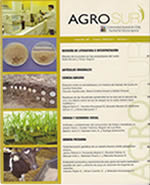Use of Trichoderma spp. and copper hydroxide, as a foliar treatment, for the control of late blight of potato (Phytophthora infestans)
Main Article Content
Abstract
Potato late blight, caused by Phytophtora infestans (Mont.) de Bary, is considered as the most crucial and devastating disease affecting this crop worldwide. In order to demonstrate the feasibility of employing applications of copper hydroxide fungicide (Kocide 2000®) and a mix of Trichoderma spp. on P. infestans control in potato crops in the Chiloé area, it was evaluated the in vitro and in vivo sensitivity of three strains of the Trichoderma genus (T. harzianum 1, T. harzianum 2, and T. viride) and P. infestans; and it was established the effective concentration 50 and 95 (EC50and EC95). Furthermore, it was estimated the area under the relative disease progress curve (rAUDPC), and the yield was determined. Trichoderma spp. strains were less sensitive than P. infestans to the fungicide. T. harzanium 1(EC50174.6 mg L-1 and EC95 1036.5 mg L-1) and T. harzanium 2 (EC50 158.6 mg L-1 and EC95 912.4 mg L-1) strains displayed similar behavior. T. viride was less sensitive (EC50 581.1 mg L-1 and EC95 5052.2 mg L-1). P. infestans presented a higher sensibility with EC50 6.52 mg L-1 and EC95 17.2 mg L-1. Kocide 2000® and Trichoderma spp. applications reduced the rAUDPC and maximized yields. These results demonstrate the importance of the disease management; furthermore, it suggests that Trichoderma and copper hydroxide improve crop health and yields.

